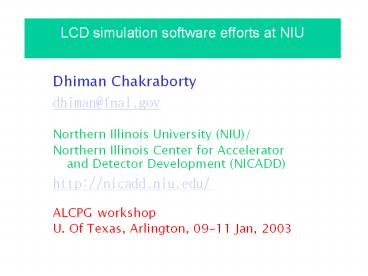LCD simulation software efforts at NIU PowerPoint PPT Presentation
1 / 19
Title: LCD simulation software efforts at NIU
1
LCD simulation software efforts at NIU
Dhiman Chakraborty dhiman_at_fnal.gov Northern
Illinois University (NIU)/ Northern Illinois
Center for Accelerator and Detector Development
(NICADD) http//nicadd.niu.edu/ ALCPG
workshop U. Of Texas, Arlington, 09-11 Jan, 2003
2
LC detector simulation software work in progress
- Transition from GISMO to GEANT4,
- Modular, flexible design towards a universal
package - Standardize interfaces to offer the best of all
implementations currently available for - detector geometry description
- input data (event generator output)
- detector simulator output
3
The LCDG4 detector simulation package(M. Arov,
R. McIntosh, V. Zutshi, D. Chakraborty,
NIU/NICADD)
- A GEANT4-based simulation program
- Not tied to any specific platform (ROOT/JAS/PAW)
- XML description of detector geometry
- Needs structural improvements for better
generality - Reads input data in STDHep format
- SIO/ROOT/ASCII output
- S(erial)IO compatible with JAS-based analysis
code - LCDG4 can write and JAS can read ROOT files
- Beta release imminent
- 2 known problems fixed during the NIU workshop
- The plan is to merge LCDG4 and MOKKA into a
single package that combines the best of both.
4
Decoupling the simulator from Root
- LCDG4 is adapted from LCDRoot (M. Iwasaki, T.
Abe), - Root internal classes replaced by STL, CLHEP,
- Now a standalone simulation program, not tied to
any other application/analysis environment, - I/O compatible with the SLAC/HEP.LCD library
JAS, - Root output capability is preserved as an option.
5
(No Transcript)
6
Advantages of the SIO format
- (sequential) access to very large files without
overburdening memory, - Allows simultaneous writing to multiple streams,
- Has built-in file compression, which is important
in view of large event sizes.
7
Non-projective and non-rectangular cell
geometries (in the digitizer)
- Gismo-based simulator only allows towers of
constant (??,?f), - An entirely projective tower design is not
optimal for an E-flow calorimeter, - (r,?) range is too large for uniform scaling.
- Particular non-projective and non-rectangular
geometries have been simulated in LCDG4 although
more work is needed to make it more general and
flexible, - Projective rectangular geometries are supported
just as in Gismo.
8
NIU Prototype
Z(k)
(j,k)
Layer (i)
(0,2)
Cell (j, k)
(-1,1)
(1,1)
f(j)
(0,0)
(-1,-1)
(1,-1)
(0,-2)
The Cell neighborhood
9
Preliminary test results
- Sampling fractions
- Passes order-of-magnitude sanity check, but
perhaps not quite correct - being checked for
bugs.
Simulator EM frac Had frac
Gismo 0.02187 0.06338
LCDG4 0.05936 0.07421
10
Total (EMHAD) energy 10 GeV p
entries
1001.0
min
0
max
16.318
mean
9.9900
rms
1.8152
Using LCDG4 with NICADD-designed detector
11
Total HAD energy 20 GeV p
12
Measured energy vs nhits in HCal 20 GeV p
Shape ok, but horizontal scale is 7x Gismo!
13
Hcal longitudinal shower profile of 10 GeV p
14
Total energy measured in Hcal 10 GeV p (1000
events)
15
SIO file contents
- Event header
- Ecal hit list
- Hcal hit list
- Tracker and muon info
- MC particle table
16
How to check it out
- http//nicadd.niu.edu/simulations/software/
- Source binary (Linux) are available
- lcdg4-bin,tar.gz and materials.tar.gz
- the shell command is
- gt lcdg4 b input_file.xml output_file.sio
Detector_ID MacroFile HepEvt_File
17
Known problems, things to do
- Primaries absent from the MC particle table
- Cause found, figuring out fundamental changes in
container structures which will optimize speed
will also cure this problem. - Too many hits, excess energy may be due to
overcounting (?), the above procedure should fix
this as well. - Geometry is hard-coded in the non-projective
version. Need to combine with the projective
version, make it more general and flexible. - Some more integration/packaging needed.
18
Detector representation issues
- Goals
- portability easy exchange of detector models
- flexibility -- easy changes in detector
configuration - uniformity (universality) in detector
description for - comparisons and cross checks across detectors.
User
GUI editor
API
Geometry Database (mySQL?)
- Driver API-handler layer
API
API
API
Det. Sim.
Reconstruction
Analysis
19
Summary and plans
- A stand-alone simulation program based on GEANT4
is ready for testing. - Order events online at http//nicadd.niu.edu/
- Has all the capabilities of Gismo, plus some
more. - A few problems being fixed.
- Emphasis on the need for global integration
working with SLAC, CALICE, to combine the best of
Mokka and LCDG4 into one simulation package. - Figuring out the recipe for detector geometry
description is a major challenge ahead. - Start with a lightweight, flexible, functioning
system. - Documentation manuals, tutorials, FAQs,
- Its a major undertaking collaborator(s)
wanted.

